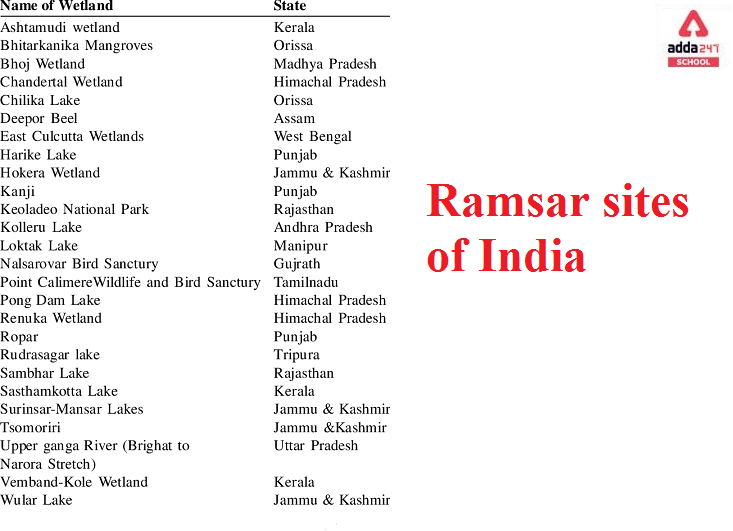All 46 Ramsar Sites in India
List of Ramsar sites in India is available here. In India, there are 46 Ramsar sites. The Ramsar Convention considers these wetlands to be of “international importance.”
Wetlands are one of India’s most endangered ecosystems, according to WWF-India. The country’s wetlands have been harmed by the loss of vegetation, salinization, excessive inundation, water pollution, invasive species, excessive development, and road construction. Thol and Wadhwana in Gujarat, and Sultanpur and Bhindawas in Haryana, were among the four new sites added in 2021. Ramsar Sites span an area of approximately 1,083,322 hectares.
46 Ramsar Sites in India in Hindi
भारत में 46 रामसर स्थल हैं। रामसर कन्वेंशन इन आर्द्रभूमियों को “अंतर्राष्ट्रीय महत्व” का मानता है।
डब्ल्यूडब्ल्यूएफ-इंडिया के अनुसार आर्द्रभूमि भारत के सबसे लुप्तप्राय पारिस्थितिक तंत्रों में से एक है। वनस्पति के नुकसान, लवणीकरण, अत्यधिक बाढ़, जल प्रदूषण, आक्रामक प्रजातियों, अत्यधिक विकास और सड़क निर्माण से देश की आर्द्रभूमि को नुकसान पहुंचा है। गुजरात में थोल और वाधवाना, और हरियाणा में सुल्तानपुर और भिंडावास, 2021 में जोड़े गए चार नए स्थलों में से थे। रामसर साइटें लगभग 1,083,322 हेक्टेयर क्षेत्र में फैली हुई हैं।
Read About: Afforestation Meaning
46 Ramsar Sites in India: List
-
-
- Ashtamudi Wetland
- Beas Conservation Reserve
- Bhitarkanika Mangroves
- Bhoj Wetland
- Chandra Taal
- Chilika Lake
- Deepor Beel
- East Kolkata Wetlands
- Harike Wetland
- Hokera Wetland
- Kanjli Wetland
- Keoladeo National Park
- Keshopur-Miani Community Reserve
- Kolleru Lake
- Loktak Lake
- Nalsarovar Bird Sanctuary
- Nandur Madhameshwar
- Nangal Wildlife Sanctuary
- Nawabganj Bird Sanctuary
- Parvati Aranga Bird Sanctuary
- Point Calimere Wildlife and Bird Sanctuary
- Pong Dam Lake
- Renuka Lake
- Ropar Wetland
- Rudrasagar Lake
- Saman Bird Sanctuary
- Samaspur Bird Sanctuary
- Sambhar Lake
- Sandi Bird Sanctuary
- Sarsai Nawar Jheel
- Sasthamkotta Lake
- Sundarban Wetland
- Surinsar-Mansar Lakes
- Tsomoriri
- Upper Ganga River
- Vembanad-Kol Wetland
- Wular Lake
- Asan Barrage
- Kanwar Taal Lake
- Sur Sarovar
- Lonar Lake
- Tso Kar
- Bhindawas Wildlife Sanctuary
- Sultanpur National Park
- Thol Lake Wildlife Sanctuary
- Wadhvana Wetland
-
First Ramsar site of India
Ashtamudi Wetland
It is First Ramsar Site of India. A natural backwater in Kerala’s Kollam district. It is fed by the rivers Kallada and Pallichal. At Neendakara, a well-known fishing port, it forms an estuary with the sea.
46 Ramsar Sites in India for UPSC Exam
Ashtamudi Wetland
A natural backwater in Kerala’s Kollam district. It is fed by the rivers Kallada and Pallichal. At Neendakara, a well-known fishing port, it forms an estuary with the sea.
Beas Conservation Reserve
A 185-kilometre length of the Beas River predominantly in Punjab’s northwestern corner. The river winds its way down from the Himalayan foothills to the Harike Headworks, where it is split into several channels. The river’s islands, sand bars, and braided channels provide a complex ecosystem that supports significant species. Along this stretch, more than 500 bird species have been identified, as well as more than 90 fish species.
Bhitarkanika Mangroves
The Bhitarkanika Wildlife Sanctuary was established in 1975 and covers 672 square kilometres. In September 1998, the sanctuary’s main area of 145 km2 was designated as Bhitarkanika National Park.
Bhoj Wetland
It is made up of two lakes in the city of Bhopal, Madhya Pradesh’s capital. The Bhojtal (Upper Lake) and the Lower Lake, which are located west of the city centre, are the two lakes. It’s a reservoir that was built by humans. Every year, around 20,000 birds are counted. In 2002, the Ramsar Convention designated Bhoj Wetland as a wetland of international significance.
Chandra Taal
Near the Kunzam pass, which connects the Himalayan and Pir Panjal ranges, a high-altitude lake flows to the Chenab River of the Western Himalayas (4,337 m asl).
Chilika Lake
A brackish water lagoon comprising about 1,100 km2 in the districts of Puri, Khordha, and Ganjam on India’s east coast, at the mouth of the Daya River flowing into the Bay of Bengal. It is India’s largest coastal lagoon and the world’s second-largest lagoon.
Deepor Beel
A permanent freshwater lake in a former Brahmaputra River channel. It is both biologically significant and necessary as the city of Guwahati’s sole major stormwater holding basin. The beel is a migratory flyway staging location, and some of Assam’s biggest concentrations of aquatic birds can be seen there, especially in the winter.
East Kolkata Wetlands
The site’s resource recovery methods, built by local people over time, have saved the city of Kolkata from the costs of developing and operating wastewater treatment plants, making it a world-renowned model of a multiple-use wetland. The wetland serves as an urban facility for treating the city’s wastewater and repurposing the treated water for horticulture and agriculture via effective nutrient recovery.
Harike Wetland
At the confluence of two rivers, there is a shallow water reservoir with thirteen islands. 70% of the lake is covered with dense floating vegetation.
Hokera Wetland
Hokera Wetland is barely 10 kilometres from the gorgeous paradise of Srinagar, in the northwest Himalayan biogeographic province of Kashmir, on the back of the snow-draped Pir Panchal (1,584 m asl).
Newest Ramsar Sites in India
Chilika Lake in Odisha
Keoladeo National Park in Rajasthan
Harike Lake in Punjab
Loktak Lake in Manipur
Wular Lake in Jammu and Kashmir.









 AILET 2026 AIR 1: Check Full Toppers Lis...
AILET 2026 AIR 1: Check Full Toppers Lis...
 AILET Result 2026 OUT, How to Download S...
AILET Result 2026 OUT, How to Download S...
 CUET PG Crash Course 2026: Subject-Wise ...
CUET PG Crash Course 2026: Subject-Wise ...














